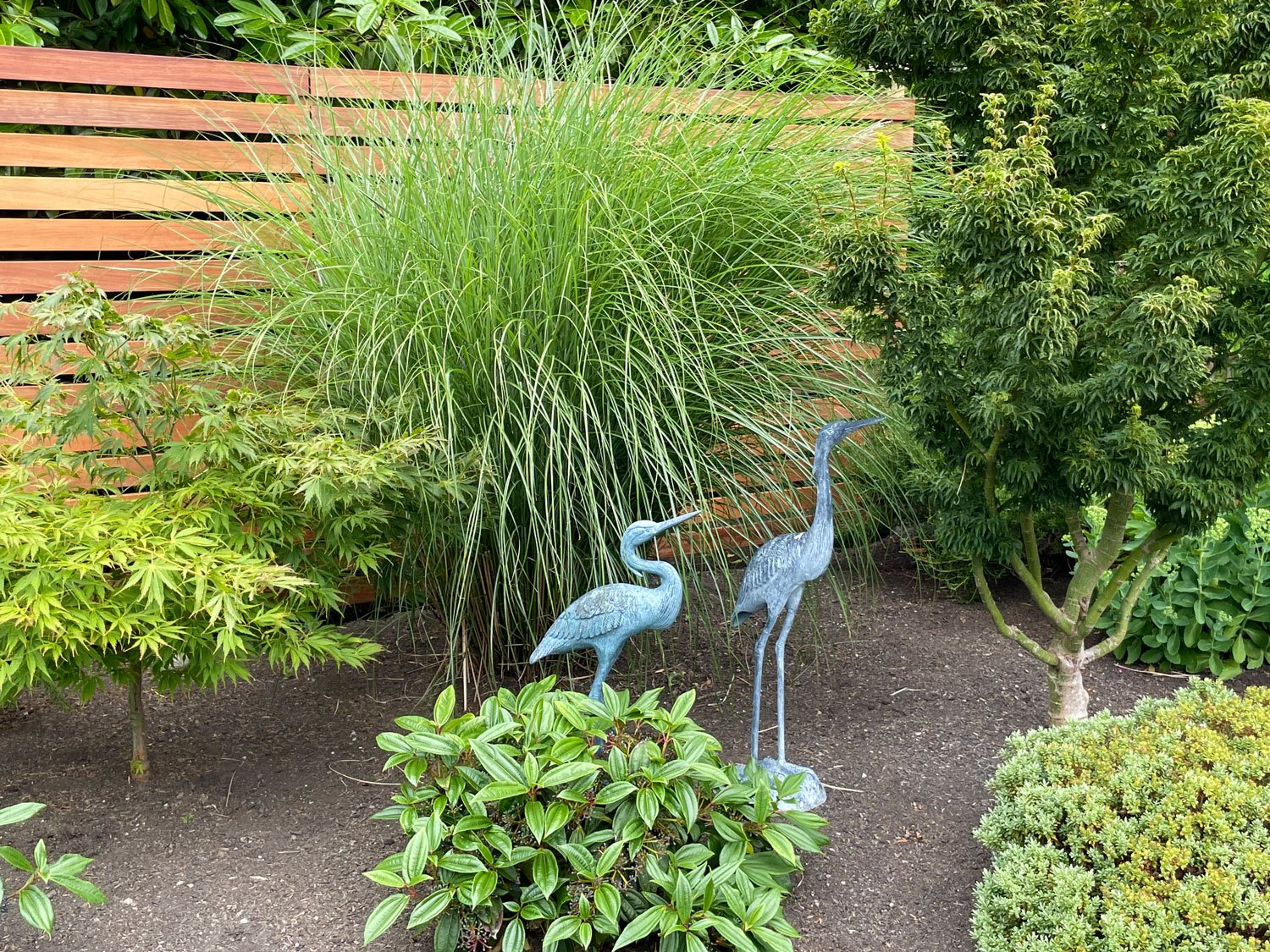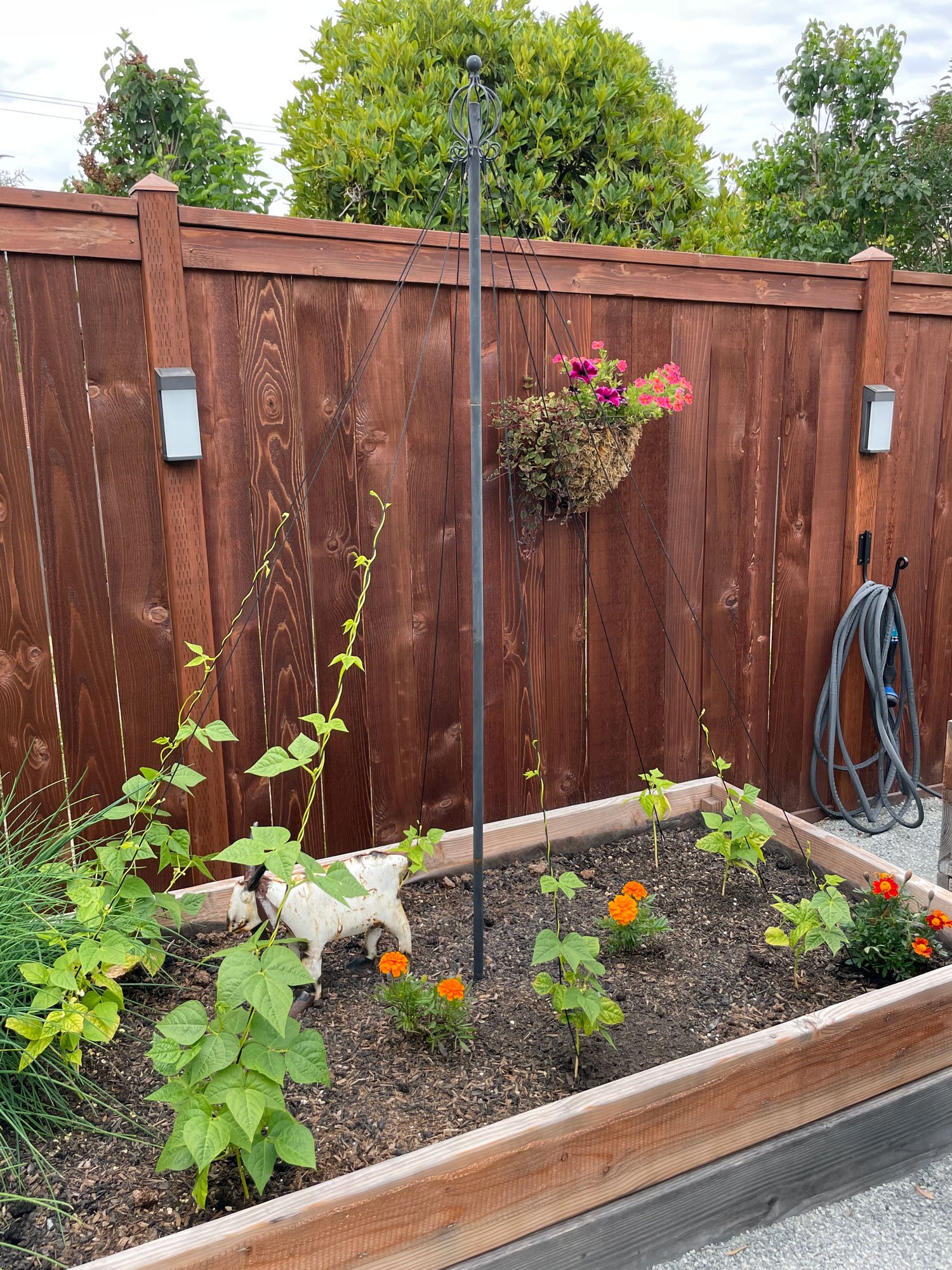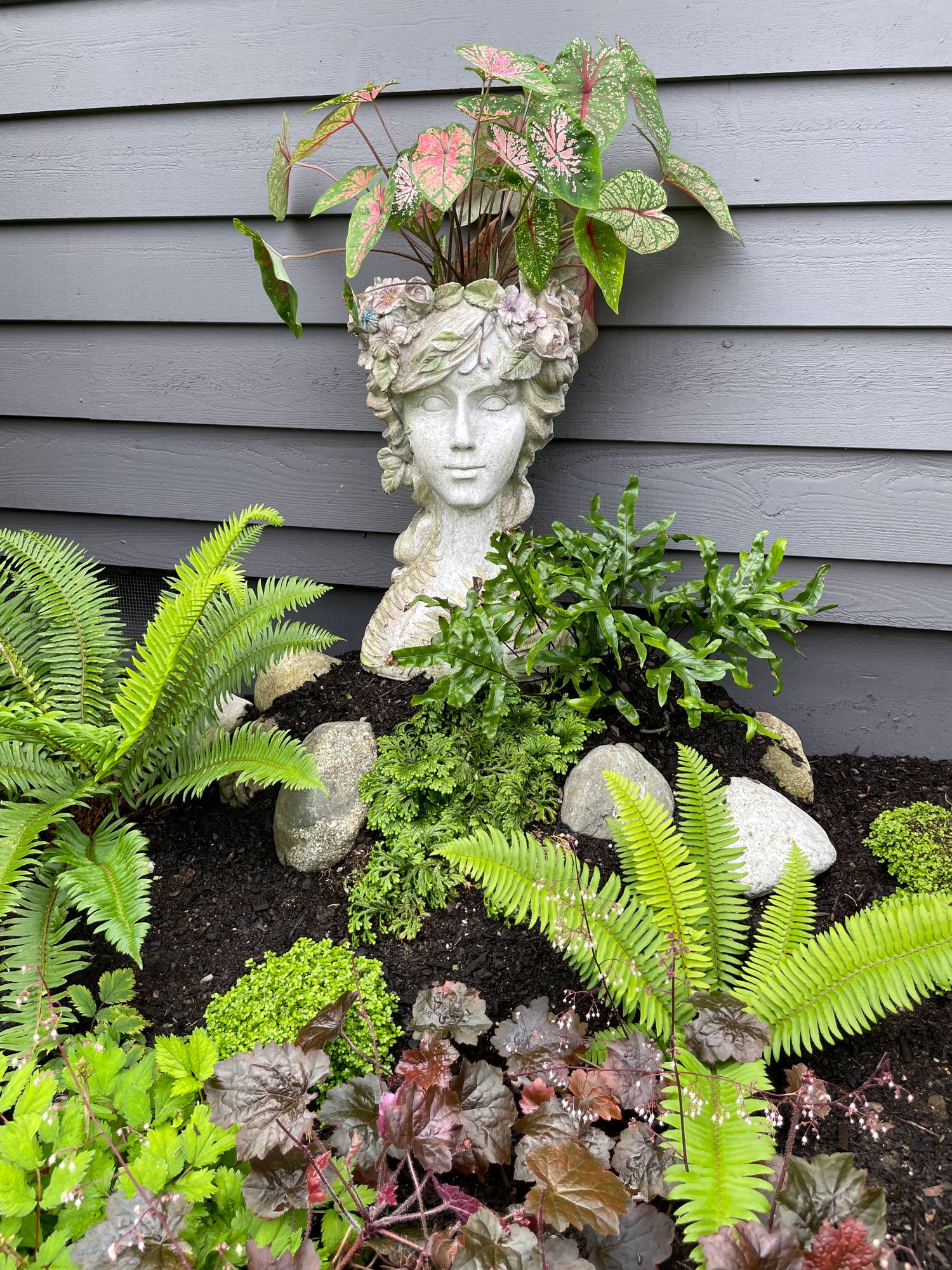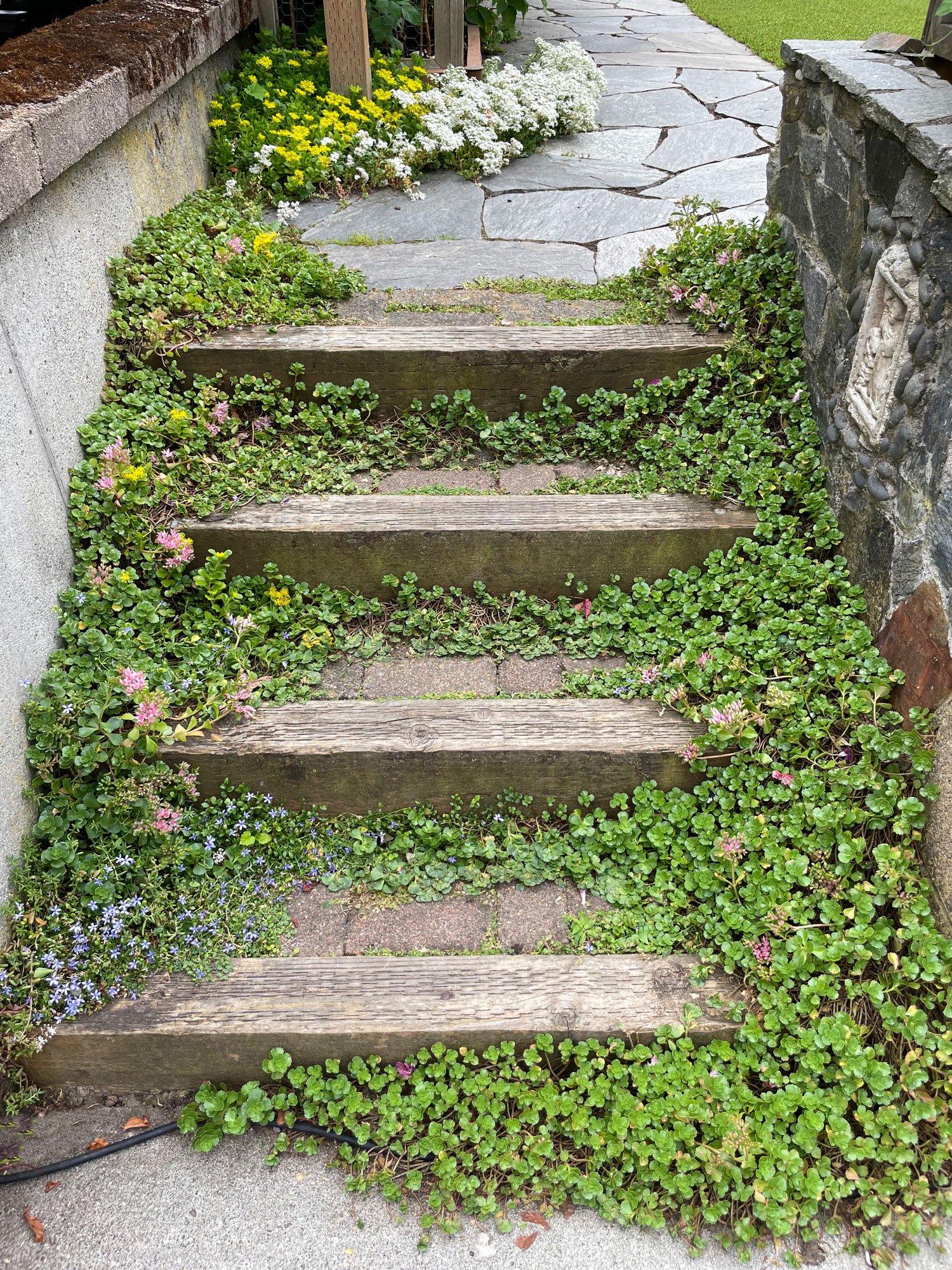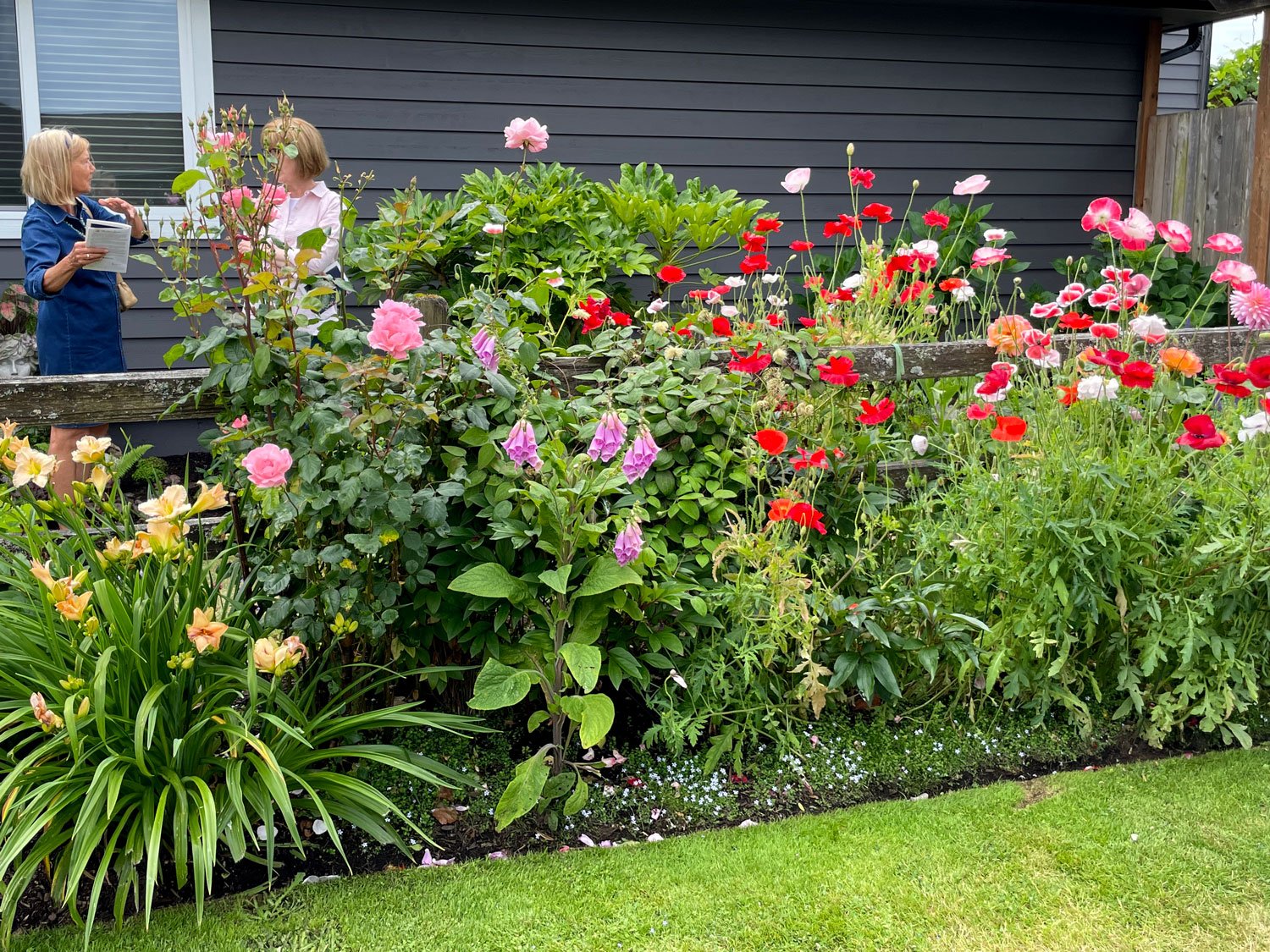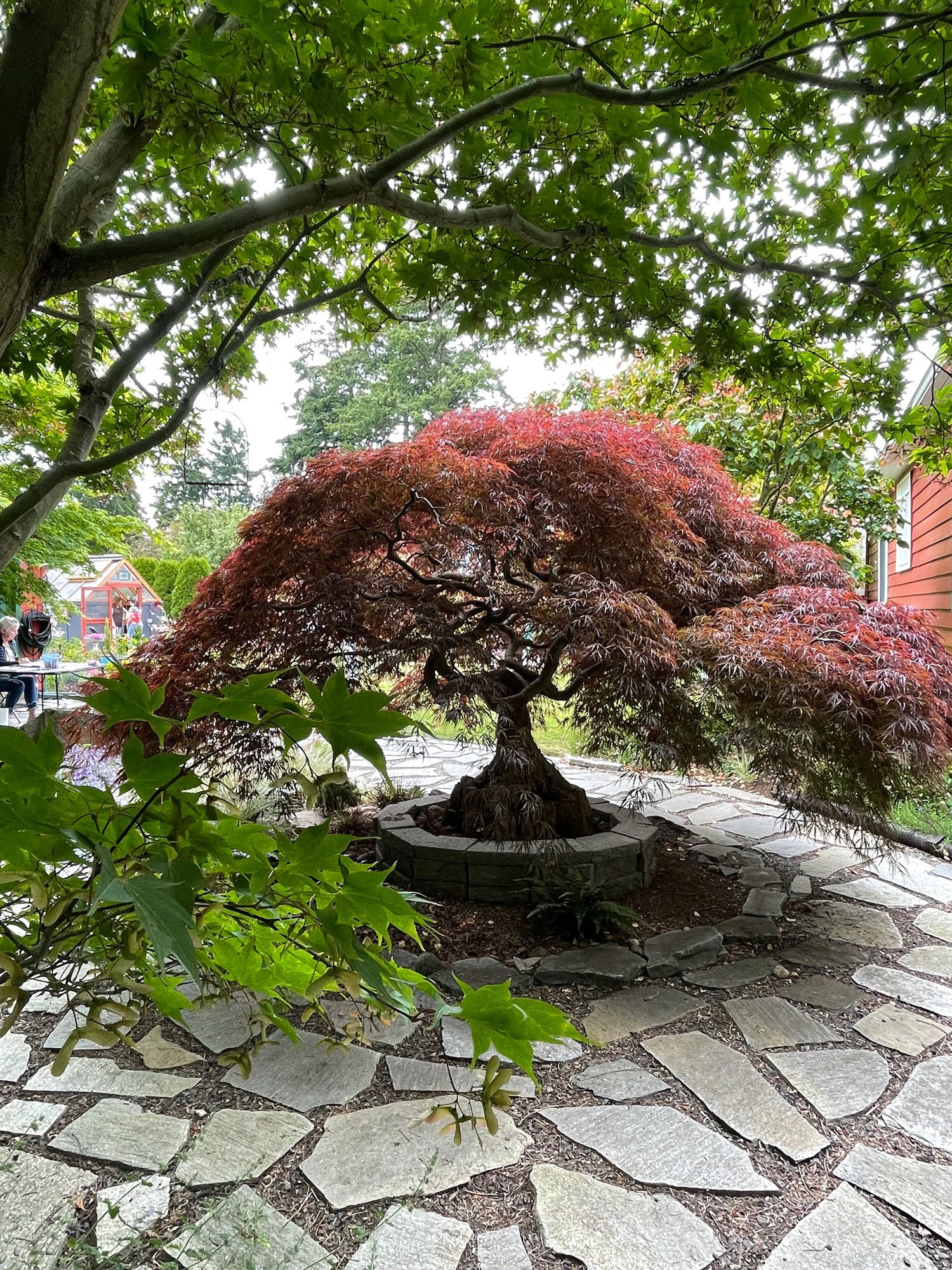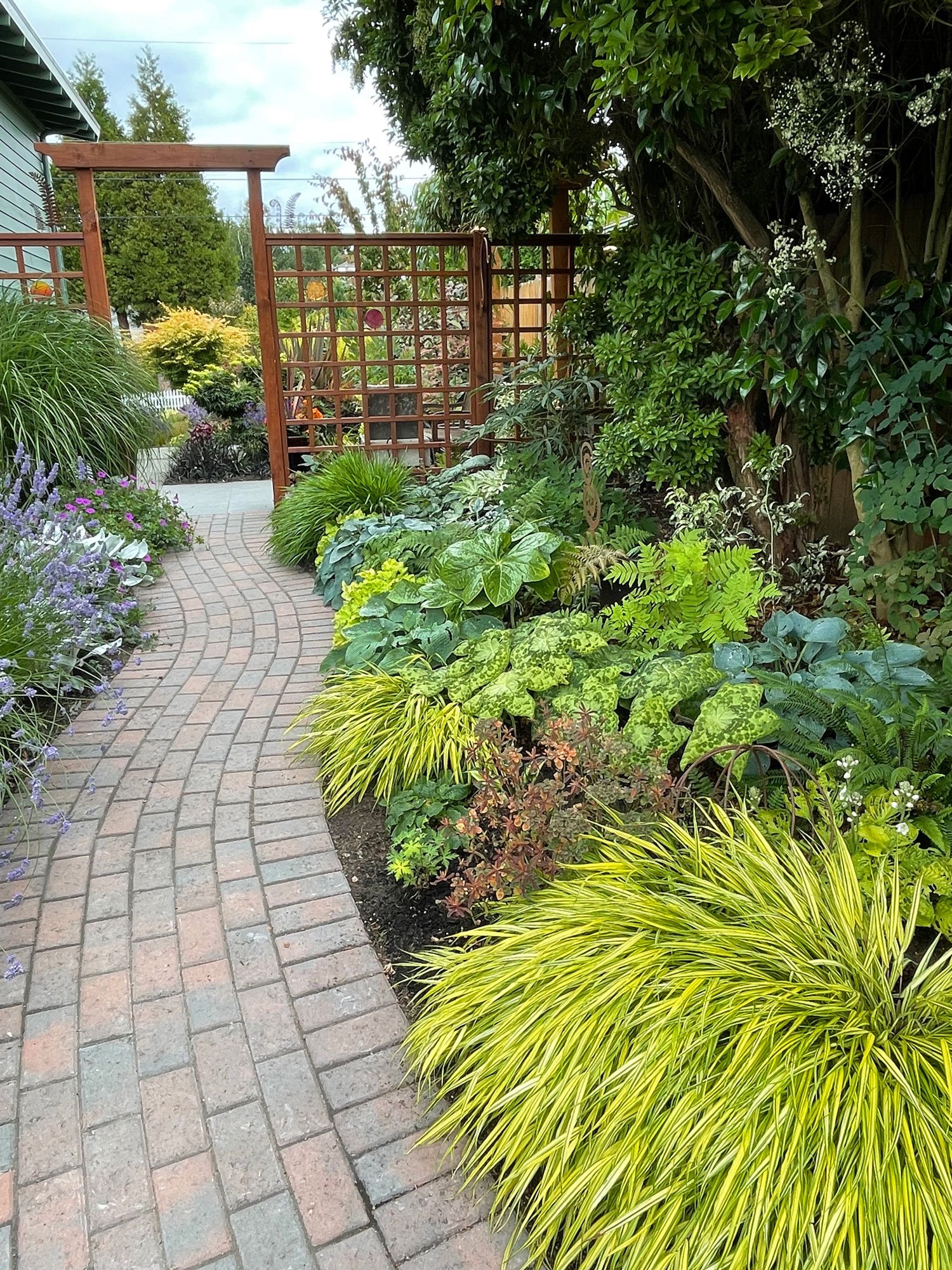I had the pleasure of attending the Edmonds Garden Tour this month and I came away filled with inspiration and excited to try out some new ideas in my garden. It may seem like “tour-worthy” gardens are unattainable, but the garden tour taught me that incorporating the fundamentals of good design and adding a dash of personality can really bring your garden to a new level.
Here are seven of my favorite ideas that you can adapt to your own gardens. Enjoy!
Low maintenance does not mean sparse or boring
Not everyone wants to spend their every free moment weeding and watering their garden. If less labor and more enjoyment is your goal, rest assured that a low-maintenance garden with low-water-use plants can feel lush and look stunning. Thoughtful garden design can help conserve water and diminish runoff as well.
Basile-Witt Garden
The Basile-Witt Garden is the perfect example. After years of nurturing lawns and flower gardens, they wanted a low-maintenance landscape and a mid-century-modern look. They chose drought-tolerant plants such as Cistus (Rockrose), Yucca, Sedum, and ornamental grasses, as well as dark-leaf Japanese Maple and bright Barberry to add color to the garden.
Basile-Witt Garden
Subtle garden art adds interest while not overwhelming the landscape. The long, sinuous lines of the birds are echoed in the shape of the Miscanthus gracefully arching overhead.
Basile-Witt Garden
A cement patio surrounded by gravel and a selection of containers makes for a relaxing spot to enjoy the garden. Choosing drought-tolerant plants and keeping containers to a minimum can help cut down on watering. In fact, the Basile-Witt Garden only needs deep watering about once a month now that the plants are well established.
Dawson Garden
At the Dawson Garden, a dry riverbed curves through the garden, facilitating drainage and creating a visual path. The riverbed is planted with Daylilies, Hakonechloa (Japanese Forest Grass), Mukdenia, hardy Fuchsia, and a small Ginkgo (center).
Small details make a big impact
No matter the size of your garden, it’s the little details that sometimes make the biggest impact: the perfect pot, a pop of color, a creative flourish… Each garden on the tour offered up delightful details that made me stop and take notice.
Dawson Garden
Porter Garden
Harter Garden
Dawson Garden
Decorative glass adds impact to a wooden screen in the Dawson Garden. The Dawsons added lots of fun details to the garden beds, including this vintage pole with twine for beans to climb.
At the Harter Garden, neutral cement pots were elevated to extraordinary by their unique shapes and brightly colored succulents.
The Porters found an original way to hide an unsightly meter, transforming a palette into a piece of succulent wall art.
Porter Garden
Laue Garden
Whimsical details abounded at the Porter and Laue Gardens, including this Caladium-filled planter nestled amongst ferns in the shade and an adorable hanging planter with mini ferns and sedum.
Porter Garden
Dawson Garden
Mixed groundcovers transform this stairway into a focal point in the Porter Garden. Choose groundcovers that bloom at different times for extended interest or try a mix of colors or leaf shapes.
The Dawsons said they are always on the hunt for unique garden décor. Flea markets and thrift stores are excellent sources, and even items that aren’t officially for the garden can be used in new ways - let your creativity run wild.
Dawson Garden
Porter Garden
The unique details of individual plants are always a source of joy. The striking colors of this ‘Princess Diana’ Clematis and this variegated Sweet Pea stopped me in my tracks. I’ve since planted two Princess Dianas in my own backyard!
Don’t be afraid of color
Whether the garden was formal, eclectic, or naturalistic, I spotted a trend of using bright colors in innovative ways. Some gardens embraced a mix of colors with open arms, while others were more selective, adding just a pop of color to accentuate a focal point or bring out contrasting tones. Red was especially popular throughout the gardens.
Laue Garden
Laue Garden
The Laue (rhymes with Maui) Garden sits on the site of an old Edmonds farm. The Laues restored the machine shed, making it into a workshop painted a dramatic red brick that brings out the fresh, spring-green tones of ferns and a Japanese Maple. Along the front of the workshop, the bright yellow flowers of a Black-Eyed Susan Vine contrast brilliantly.
Porter Garden
Porter Garden
Dawson Garden
Dawson Garden
Several gardens opted for bright borders in a mix of colors. The Porters framed one side of their front yard with a romantic border of poppies, foxgloves, daylilies, roses, and dahlias in shades of pink, red, peach, and yellow.
At the Dawson Garden, bright color was a dominant theme, with red, orange, and purple tones attracting attention from visitors and hummingbirds alike. Crocosmia ‘Lucifer’ played well with the lavender flowers of a compact variety of Verbena bonariensis and bright green leaves of Amsonia, while a bed of Echinacea, Kniphofia, and ornamental Sage form a riotous rainbow.
A trick for adding pops of bright color without overwhelming the garden: add colorful annuals to containers. Choosing neutral tones for the containers allows the plants to take the focus like in the photos above.
Subtle color palettes are always in style
Color minimalists and the monochromatically inclined, take heart: subtlety is never out of style! While bright colors were a trend, the use of nuanced shades of green and restrained color palettes delivered soothing landscapes with just as much design power as their colorful counterparts.
Thompson Garden
Thompson Garden
The Thompsons excelled at layering shades of green to create lush, naturalistic designs for shade. The bright, lime-green foliage of Aralia ‘Sun King’ was planted with similarly toned Hakonechloa and the cooler green tones of ferns and hostas.
The white and green leaves of a Cornus controversa ‘Variegata,’ also known as the Wedding Cake Tree, positively glow in the sunlight and contrast with the surrounding dark green maples and shade perennials.
Basile-Witt Garden
With less variation in color, the textures of plants really come into play. The cascading sword-like leaves of Miscanthus are a dramatic contrast to the deeply cut leaves of this Japanese Maple.
The Laue Garden
Dawson Garden
Not only do the leaves of hardy Fuchsia, Heucherella, and Hakonechloa at the Laue Garden complement each other, but the delicate, starlike flowers of the Heucherella and the pendulous pale pink blossoms of the Fuchsia produce an ethereal look.
If you enjoy color but want a sophisticated look, try limiting your color palette. A planting of Phormium (New Zealand Flax), Gaura, Mukdenia, Cotinus (Smoke Bush), gold-leafed Spirea ‘Ogon,’ and burgundy Eupatorium at the Dawson Garden offers up a variety of leaf forms and the perfect mix of gold, pink, and bronze tones.
Luque Garden
Kimbrough Garden
Several of the most striking plant combinations on the tour involved four colors or less. Two beautiful examples of a restrained color palette are the green, purple, and white color scheme of a bed planted with Ferns, Violas, and various groundcovers at the Luque Garden, and the interplay of warm pinks and purples with bright, golden greens at the Kimbrough Garden, where Hydrangea and Astilbe frame a Sumac tree.
Embrace the elements
The four elements of matter - earth, water, air, and fire - can be highlighted in creative ways throughout a garden. Whether they are represented literally or metaphorically, they complete the landscape and delight the senses.
Water
Kimbrough Garden
Laue Garden
Luque Garden
Dawson Garden
The soothing sounds of water were featured in many of the gardens. The Laue’s dug a small pond and creek where they can enjoy the reflections of maples on the water’s surface.
A more formal option is a fountain, either as a centerpiece or tucked into a planting bed. At the Kimbrough Garden, a formal stone fountain was modernized with a whimsical selection of low-maintenance succulents instead of water.
Dawson Garden
Harter Garden
Using stones to construct a dry riverbed is another way to represent water with the added bonus of helping to reduce rainwater runoff. The Harter Garden used large stones to outline the structure of a Japanese garden, with a dry riverbed crossed by a decorative bridge.
Thompson Garden
Thompson Garden
Thompson Garden
Thompson Garden
The Thompsons built their garden around a natural water source, restoring a series of cement ponds constructed in the 1930’s to harness a creek running through the property. Planted with ferns, hostas, and other shade-lovers, the natural, woodland design is breathtaking and offers ever-changing reflections on the surfaces of the ponds.
Air
Harter Garden
Laue Garden
Thompson Garden
Dawson Garden
The element of air was emphasized in a moon garden with a beautiful arch and bells that sway in the breeze, while the sound of the wind through a grove of Himalayan Birch in the Thompson’s front yard offers a peaceful welcome to visitors. Both the Laues and the Dawsons used owls to represent the air element (and possibly scare off marauding birds and mice as well).
Earth & Fire
Luque Garden
Basile-Witt Garden
A stone patio is the perfect spot to relax around the fire pit on a chilly PNW evening. The angular lines of the Adirondack chairs are echoed by square trellises and softened by the rounded shapes of the patio and fire pit.
At the Basile-Witt Garden, the clean lines of floating pavers and a large decorative rock accentuate the deep brown of perfectly mulched and weeded garden earth.
Frame it
Landscapes, especially larger ones, benefit from the creation of “garden rooms” to break up the space. Peek-a-boo views are also a fantastic way to spotlight treasured plants or areas.
Kimbrough Garden
Porter Garden
Porter Garden
Laue Garden
Both the Kimbrough and Laue Gardens use a framing technique to produce a “window” onto a special plant or area in the garden.
At the Porter Garden, “rooms” were created with whimsical seating areas and fencing. A vibrant sweet pea wall separates a seating area and a dog run. In another spot, planter boxes with a built-in bench offer a peek-a-boo view of the vegetable garden.
Harter Garden
A mature climbing Hydrangea frames a small patio seating area and provides welcome shade in the summer.
Follow the path
A well-defined garden path leads the eye as well as the body. Both straight lines with clean angles and sinuous curves can be effective, depending on the style of the garden. Many of the gardens on the tour used elaborate hardscaping to create a specific look.
Dawson Garden
Kimbrough Garden
Dawson Garden
Curves and straight lines harmonize in both the Dawson and Kimbrough Gardens. The curved brick paths were a labor of love for the Dawsons, who hand cut the bricks to form patterns throughout their garden.
A curved gravel path gets a clean edge from grey brick at the Kimbrough Garden. The path is lined with gorgeous flowering plants like Phlox, African Daisies, and Hostas. Curves like this lead the eye further into the landscape, hinting at treasures to come.
Thompson Garden
Harter Garden
Harter Garden
Woodland gardens call for more rustic pathways. This meandering path of irregularly shaped stones, partly hidden by the graceful leaves of Ferns and Solomon’s Seal, is a great fit for the Thompson Garden.
To accentuate the entrance to a woodland moon garden, a swept dirt path leads to an arbor, where a stone walkway takes over, marking the threshold. Another naturalistic path is made of tiles embossed with leaves and surrounded by Rhododendron, fern, and Hydrangea.
I hope this virtual garden tour has given you some inspiration for your own gardens! Remember that Swansons Nursery is always ready to help with plant suggestions, design advice, and more. Come in and ask us about your space, email us, or give us a shout on social media with #heyswansons.
To learn more about the Edmonds Garden Tour and other events, visit edmondsinbloom.com.



